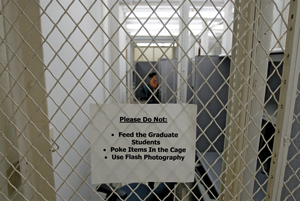New Liberal Arts building will bring together students and faculty
When College of Liberal Arts senior Mykel Estes needs a place to hang out and study between classes, he often heads to the atrium in the Red McCombs School of Business.
It’s not that Estes isn’t committed to the liberal arts or his school.
The North Texas native majors in rhetoric and writing. He’s president of the Liberal Arts Council, which is the voice of college undergraduates. And when he discusses his college education, he talks in lofty terms about broadening his horizons and honing his critical thinking skills.
But when it comes to finding a place to study, he doesn’t have many choices.
“As a Liberal Arts student, I have to use the business school’s space because we don’t have our own,” says Estes, who plans to pursue a master’s in higher education administration after he graduates next spring.
“I’ve gotten a great education here. But if I had to pick one part that’s been missing it’s that there was never one space for me to go to that I think of as a home to Liberal Arts, where I could be with my fellow students or have immediate access to faculty.”
That could change for future students by 2013 as the College of Liberal Arts moves ahead with plans for a $100 million building on the east mall that would include two dozen classrooms and auditoriums, offices for campus groups and study space for the 10,000 students who are expected to use the building each day.
Preliminary designs for the 200,000 square-foot, glass and limestone building include a sunlit atrium as its centerpiece. It will house up to a dozen college departments and programs including the Plan II Honors program and feature offices and lab space for 250 faculty. And by using some recycled materials, installing high-efficiency energy systems and including low-flow water fixtures, designers hope the building will receive silver LEED status from the U.S. Green Building Council.
When it’s done, the building will allow students and faculty from different departments to share space for the first time in decades, helping to promote collaboration. That, in turn, will help the college meet its long-term goal of having more nationally ranked programs.
“This is our shot at greatness,” Dean Randy L. Diehl says of the building’s potential to help attract top graduate students, faculty and grants. “A modern Liberal Arts building will ensure that we have the space we need to teach our students, promote world-class research and foster the collaboration and intellectual give-and-take that’s vital to a great university.”
In an unprecedented move, Diehl has looked to the college’s own resources to pay for most of the building, a first in the history of the Forty Acres. The college will pay $68 million, hoping to raise an additional $10 to $15 million from donors over the long term. President William Powers Jr. agreed this spring to have the university pay the rest of the cost of the building.
When Powers talks about the building and the future of the college, he invokes the words of former university president Harry Ransom.
“We cannot lay claim to being a comprehensive university unless we maintain excellent programs in the humanities. As Harry Ransom once wrote, ‘the humanities confront all that is vague, changeful, unpredictable, immeasurable, unknown and unknowable,’” Powers says. “It is critical that we have the best arts and humanities programs in the nation.”
Estes and other student leaders agree a new building is the way to get that done. And they’re actively promoting the plans with their peers as well as Liberal Arts Council alumni.
“We need a place,” Estes explains, “to call our own.”
A college scattered
At the start of the last century, many of the liberal arts departments were together under one roof in the original Main Building, a Victorian-Gothic structure that was torn down and replaced by the university’s iconic Tower three-quarters of a century ago.
While the original building had been an academic center, the newer version was designed primarily as a library and administrative offices.
“After it was torn down there was a building boom on campus, and this inevitably led to departments becoming more isolated and autonomous,” says Anthropology Department chair Sam Wilson, who also heads the faculty advisory committee for the new building. “Between 1934 and the opening of the new Liberal Arts building we have never had so much of the college under one roof as we will in the new building.”
Today, the College of Liberal Arts — with its 20 departments, more than two-dozen centers, 14,000 students and 700-plus professors and lecturers — is spread across 30 buildings. History, English, Government and several other departments are in centrally located sites on the south mall and will stay there when the new building is done. But other departments are farther removed from the heart of campus, oftentimes in space they’ve outgrown.

The nationally renowned Population Research Center (PRC), for example, is housed high in the Tower, on six cramped floors originally designed in the 1930s as library stacks.
The exposed steel beams, pipes and heating ducts, the makeshift, windowless cubicles, and the cage-like, metal partitions serve as evidence of that history — and as an ongoing obstacle to recruiting new faculty or graduate students.
“We’ve actually had reaction from potential academic recruits who looked at that space and said they didn’t want any part of it,” Sociology Department chair and former PRC director Robert Hummer says of the center, the only academic unit in the Tower. “And when the National Institutes of Health folks come to visit, the reaction is ‘you guys have to get out of here.’”
That will likely happen when the new building goes up.
Even more frustrating than cramped quarters is being physically separated from colleagues in related disciplines, some professors say.
The two-year-old Schusterman Center for Jewish Studies, for example, draws faculty from a half dozen departments, such as Middle Eastern studies, with offices that are across campus from the center’s Mezes Hall operations.
“There’s no water cooler collegiality,” says center director Robert Abzug.
“To be in the midst of a community on a big, big campus, it makes things happen,” says Abzug. “Conversations happen, friendships blossom.”
The Schusterman Center will likely have several faculty offices and space for its growing collection of Jewish literature and media in the new building — along with greater access to colleagues from other departments.
For many social scientists, working closer to one another is more than just a nicety: oftentimes, demonstrating a synergy across different disciplines is key to landing federal grants. It will also help scholars better collaborate on some of the key global challenges they’re studying — from religious and cultural conflicts to shifting demographic trends brought about by migration and immigration.
“These problems are often the topics of faculty and students in the College of Liberal Arts,” says Diehl. “The proposed Liberal Arts building, primarily housing the social sciences, will anchor the new heart of the campus and stand as core space for research, collaboration and solutions to these kinds of issues.”
From vision to reality
Serious discussion about a Liberal Arts building began nearly a decade ago and gained momentum over the past couple years as college officials identified a site and came up with a plan both to pay for construction and to limit costs by tying it to the Student Activity Center, which is under construction next to the Gregory Gymnasium.
To make room for the new building, Steindam Hall will be torn down and the ROTC will move from its offices there into a smaller space in the geography building. On an increasingly crowded urban campus, this is among the last sites available for major new construction — and college leaders hope it meets their needs for years to come.
San Antonio-based Overland Partners, whose past projects include the Texas A&M Bonfire Memorial, the Lady Bird Johnson Wildflower Center and the Clear Channel Communications headquarters in San Antonio, will design the building.
“Flexibility and shared space are the keys,” says Wilson. “It’s not at all practical and really not even possible to say that this or that department is going to need 50,000 square feet of space in 25 years. There may be departments in the building that do not even exist now. So we tried to make the building versatile, so that academic units can grow and change.”
Once construction is finished on the Student Activity Center — which is being financed through a student-approved fee and will include restaurants, study space and a theatre — workers expect to immediately move on to the Liberal Arts building. By treating the two building as different phases of a single project, the university hopes to reduce construction startup costs by about $15 million.
The more money that comes from donors, the less the school will have to pay from its own coffers, freeing up that extra money for other academic programs. Extensive naming opportunities are available, including for the areas that will be used most heavily by students.
In all, the building will have 4,000 square feet of student space including a lounge and patio and will be connected to the new Student Activity Center.
Native Texas flora will also be planted around the new Liberal Arts building and, as part of the project, the east mall fountain will be redesigned to include a grand staircase that will make it more of a gateway to campus for the thousands of students who come to the university from that direction each day.
The 70-year-old Plan II Honors program will also have its own study space where students hope the program will continue its tradition of keeping a perpetually-stocked cookie jar out for them.
Even that jar, they say, hasn’t always been enough to draw students to Plan II’s current space in the Hogg Building, which offers what they call a “King Arthur” study table as well as computer labs and academic advising.
“If you have 20-odd students in the main room, it’s cramped there,” says Plan II junior Katherine Hysmith, who has a joint major in linguistics and French and works as a Plan II admissions assistant.
“A new bright building with space for students that’s easy to find and easy to navigate will be great,” she says. “It’s like a new face to the university.”
